Financial Analysis and Funding Sources in Travel and Tourism
VerifiedAdded on 2024/05/27
|16
|3506
|356
Report
AI Summary
This report provides a comprehensive analysis of finance and funding in the travel and tourism industry, focusing on the importance of cost, volume, and profit in financial management. It uses Carnival Corporation & plc as a case study to explain these concepts and analyze pricing methods and factors influencing profit. The report also assesses the use of management accounting information as a decision-making tool for Dalata Hotel Group plc, interpreting their financial accounts for 2016 and 2017 using various financial ratios. Furthermore, it examines the sources and distribution of funding for capital projects in tourism, concluding with a summary of key findings and recommendations. The report offers a detailed overview of financial strategies and considerations relevant to travel and tourism businesses.
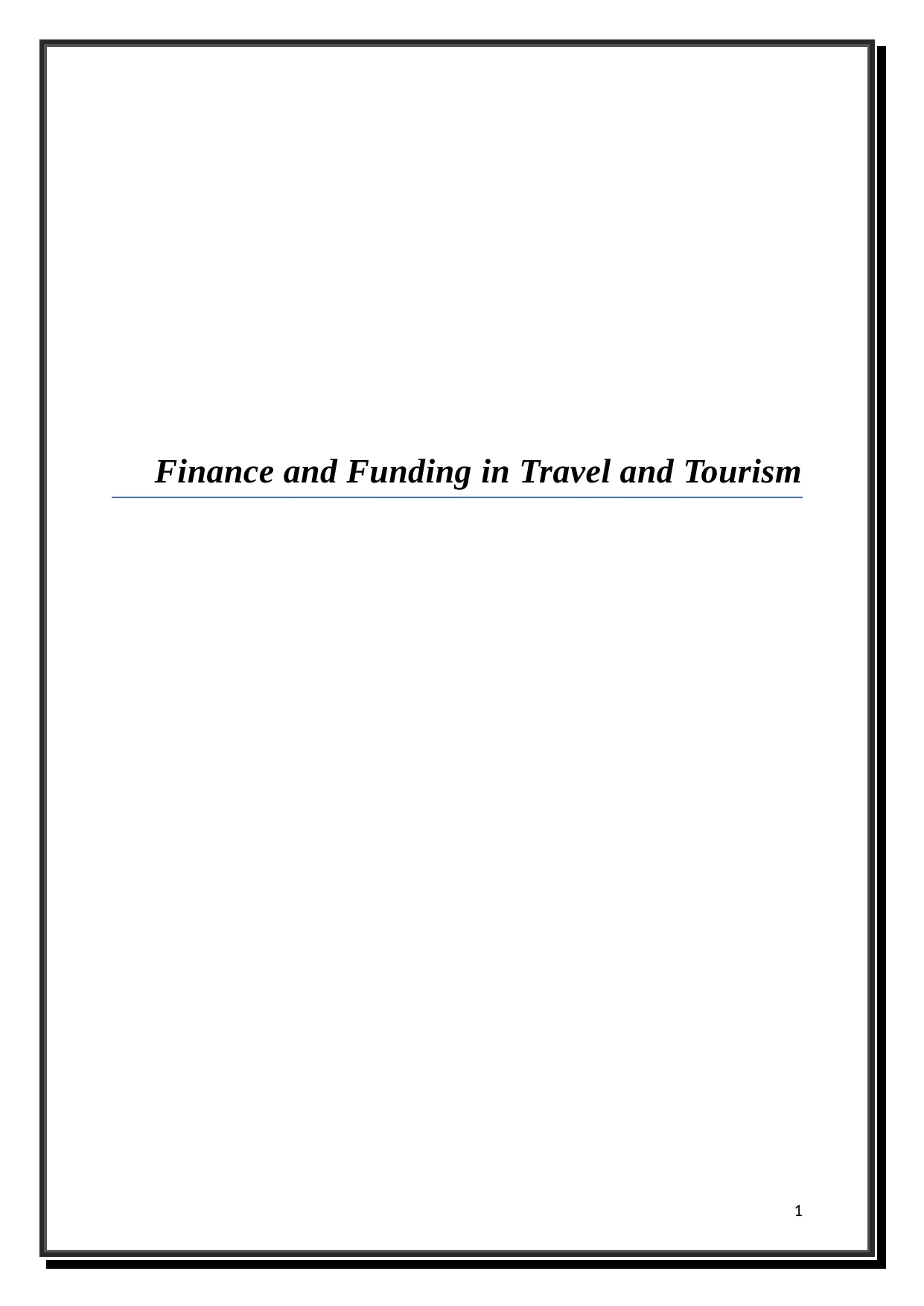
Finance and Funding in Travel and Tourism
1
1
Paraphrase This Document
Need a fresh take? Get an instant paraphrase of this document with our AI Paraphraser

Table of Contents
Introduction...........................................................................................................................................3
Task 1....................................................................................................................................................4
P1.1 explain the importance of costs and volume in financial management of travel and tourism
businesses using Carnival Corporation & plc as your case study.......................................................4
P1.2 analyse pricing methods used in the travel and tourism sector. You should use relevant
examples from different cruise brands of Carnival Corporation & plc..............................................6
P1.3 analyse factors influencing profit for travel and tourism businesses using Carnival
Corporation & plc cruise brands as your case study..........................................................................7
Task 2....................................................................................................................................................8
P2.1 explain different types of management accounting information that could be used in travel
and tourism businesses using Dalata Hotel Group plc as your case study.........................................8
P2.2 assess the use of management accounting information as a decision-making tool for Dalata
Hotel Group plc.................................................................................................................................8
Task 3..................................................................................................................................................10
3.1 interpret financial accounts of Dalata Hotel Group plc for the year ended 31st December 2017
showing at least two years performance (for example comparing 2017 to 2016)............................10
Task 4:.................................................................................................................................................15
4.1 analyse sources and distribution of funding for the development of capital projects associated
with tourism.....................................................................................................................................15
Conclusion...........................................................................................................................................17
References...........................................................................................................................................18
2
Introduction...........................................................................................................................................3
Task 1....................................................................................................................................................4
P1.1 explain the importance of costs and volume in financial management of travel and tourism
businesses using Carnival Corporation & plc as your case study.......................................................4
P1.2 analyse pricing methods used in the travel and tourism sector. You should use relevant
examples from different cruise brands of Carnival Corporation & plc..............................................6
P1.3 analyse factors influencing profit for travel and tourism businesses using Carnival
Corporation & plc cruise brands as your case study..........................................................................7
Task 2....................................................................................................................................................8
P2.1 explain different types of management accounting information that could be used in travel
and tourism businesses using Dalata Hotel Group plc as your case study.........................................8
P2.2 assess the use of management accounting information as a decision-making tool for Dalata
Hotel Group plc.................................................................................................................................8
Task 3..................................................................................................................................................10
3.1 interpret financial accounts of Dalata Hotel Group plc for the year ended 31st December 2017
showing at least two years performance (for example comparing 2017 to 2016)............................10
Task 4:.................................................................................................................................................15
4.1 analyse sources and distribution of funding for the development of capital projects associated
with tourism.....................................................................................................................................15
Conclusion...........................................................................................................................................17
References...........................................................................................................................................18
2

Introduction:
This report has been prepared to get a clear understanding related to the volume, cost and
profits. This understanding is important for process of decision making. Case study of
Dalata Hotel Group Plc is considered for analysing the standing of management accounting
system. Dalata Hotel Group Plc’s financial publications depicts using the ratio analysis.
Multiple ratios has been calculated and discussed in detail. Financial data has been
interpreted in detail. A leaflet has been prepared which depicts the various sources of funds
and how those funds are distributed for the development of domestic and international
tourism.
3
This report has been prepared to get a clear understanding related to the volume, cost and
profits. This understanding is important for process of decision making. Case study of
Dalata Hotel Group Plc is considered for analysing the standing of management accounting
system. Dalata Hotel Group Plc’s financial publications depicts using the ratio analysis.
Multiple ratios has been calculated and discussed in detail. Financial data has been
interpreted in detail. A leaflet has been prepared which depicts the various sources of funds
and how those funds are distributed for the development of domestic and international
tourism.
3
⊘ This is a preview!⊘
Do you want full access?
Subscribe today to unlock all pages.

Trusted by 1+ million students worldwide
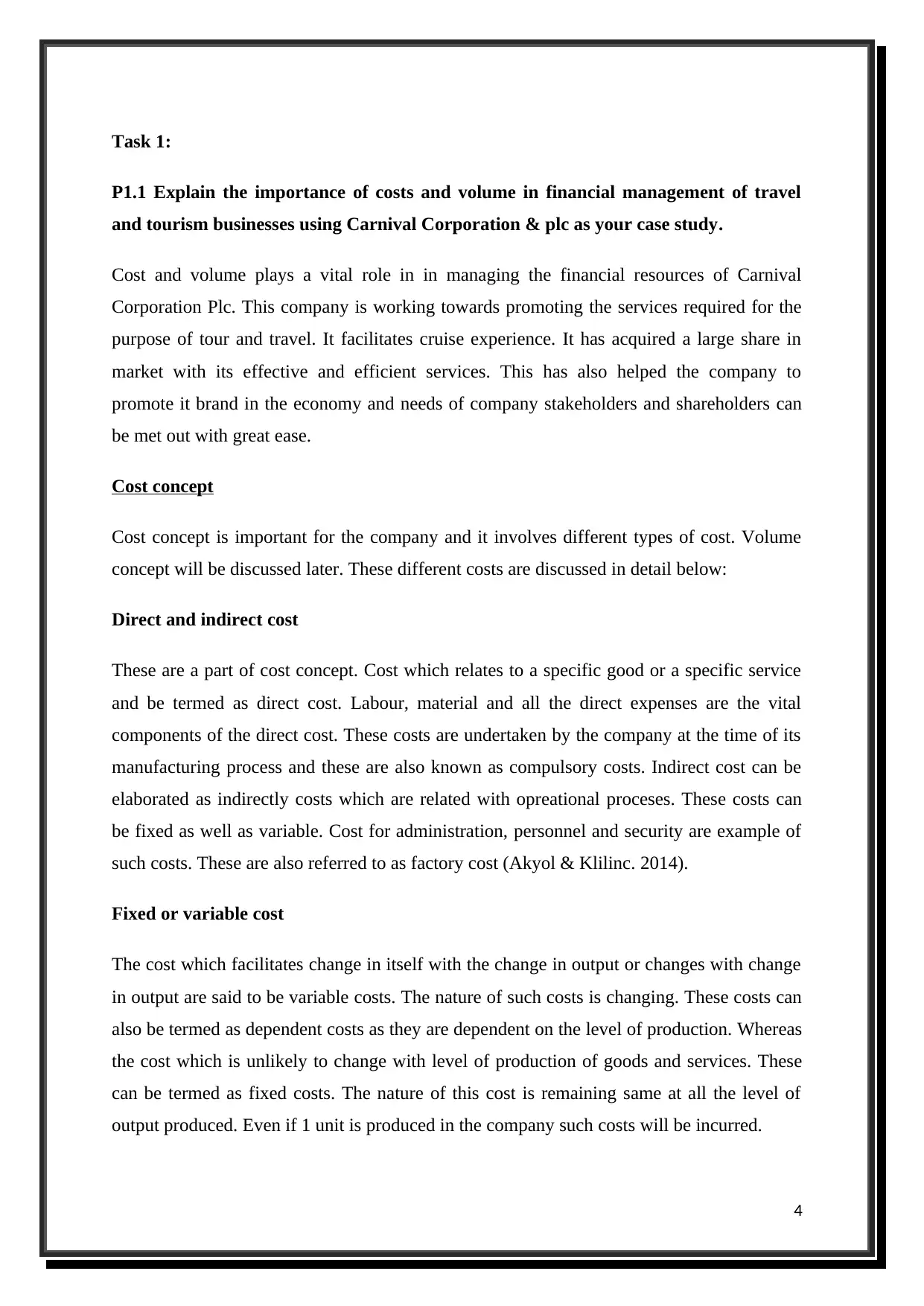
Task 1:
P1.1 Explain the importance of costs and volume in financial management of travel
and tourism businesses using Carnival Corporation & plc as your case study.
Cost and volume plays a vital role in in managing the financial resources of Carnival
Corporation Plc. This company is working towards promoting the services required for the
purpose of tour and travel. It facilitates cruise experience. It has acquired a large share in
market with its effective and efficient services. This has also helped the company to
promote it brand in the economy and needs of company stakeholders and shareholders can
be met out with great ease.
Cost concept
Cost concept is important for the company and it involves different types of cost. Volume
concept will be discussed later. These different costs are discussed in detail below:
Direct and indirect cost
These are a part of cost concept. Cost which relates to a specific good or a specific service
and be termed as direct cost. Labour, material and all the direct expenses are the vital
components of the direct cost. These costs are undertaken by the company at the time of its
manufacturing process and these are also known as compulsory costs. Indirect cost can be
elaborated as indirectly costs which are related with opreational proceses. These costs can
be fixed as well as variable. Cost for administration, personnel and security are example of
such costs. These are also referred to as factory cost (Akyol & Klilinc. 2014).
Fixed or variable cost
The cost which facilitates change in itself with the change in output or changes with change
in output are said to be variable costs. The nature of such costs is changing. These costs can
also be termed as dependent costs as they are dependent on the level of production. Whereas
the cost which is unlikely to change with level of production of goods and services. These
can be termed as fixed costs. The nature of this cost is remaining same at all the level of
output produced. Even if 1 unit is produced in the company such costs will be incurred.
4
P1.1 Explain the importance of costs and volume in financial management of travel
and tourism businesses using Carnival Corporation & plc as your case study.
Cost and volume plays a vital role in in managing the financial resources of Carnival
Corporation Plc. This company is working towards promoting the services required for the
purpose of tour and travel. It facilitates cruise experience. It has acquired a large share in
market with its effective and efficient services. This has also helped the company to
promote it brand in the economy and needs of company stakeholders and shareholders can
be met out with great ease.
Cost concept
Cost concept is important for the company and it involves different types of cost. Volume
concept will be discussed later. These different costs are discussed in detail below:
Direct and indirect cost
These are a part of cost concept. Cost which relates to a specific good or a specific service
and be termed as direct cost. Labour, material and all the direct expenses are the vital
components of the direct cost. These costs are undertaken by the company at the time of its
manufacturing process and these are also known as compulsory costs. Indirect cost can be
elaborated as indirectly costs which are related with opreational proceses. These costs can
be fixed as well as variable. Cost for administration, personnel and security are example of
such costs. These are also referred to as factory cost (Akyol & Klilinc. 2014).
Fixed or variable cost
The cost which facilitates change in itself with the change in output or changes with change
in output are said to be variable costs. The nature of such costs is changing. These costs can
also be termed as dependent costs as they are dependent on the level of production. Whereas
the cost which is unlikely to change with level of production of goods and services. These
can be termed as fixed costs. The nature of this cost is remaining same at all the level of
output produced. Even if 1 unit is produced in the company such costs will be incurred.
4
Paraphrase This Document
Need a fresh take? Get an instant paraphrase of this document with our AI Paraphraser
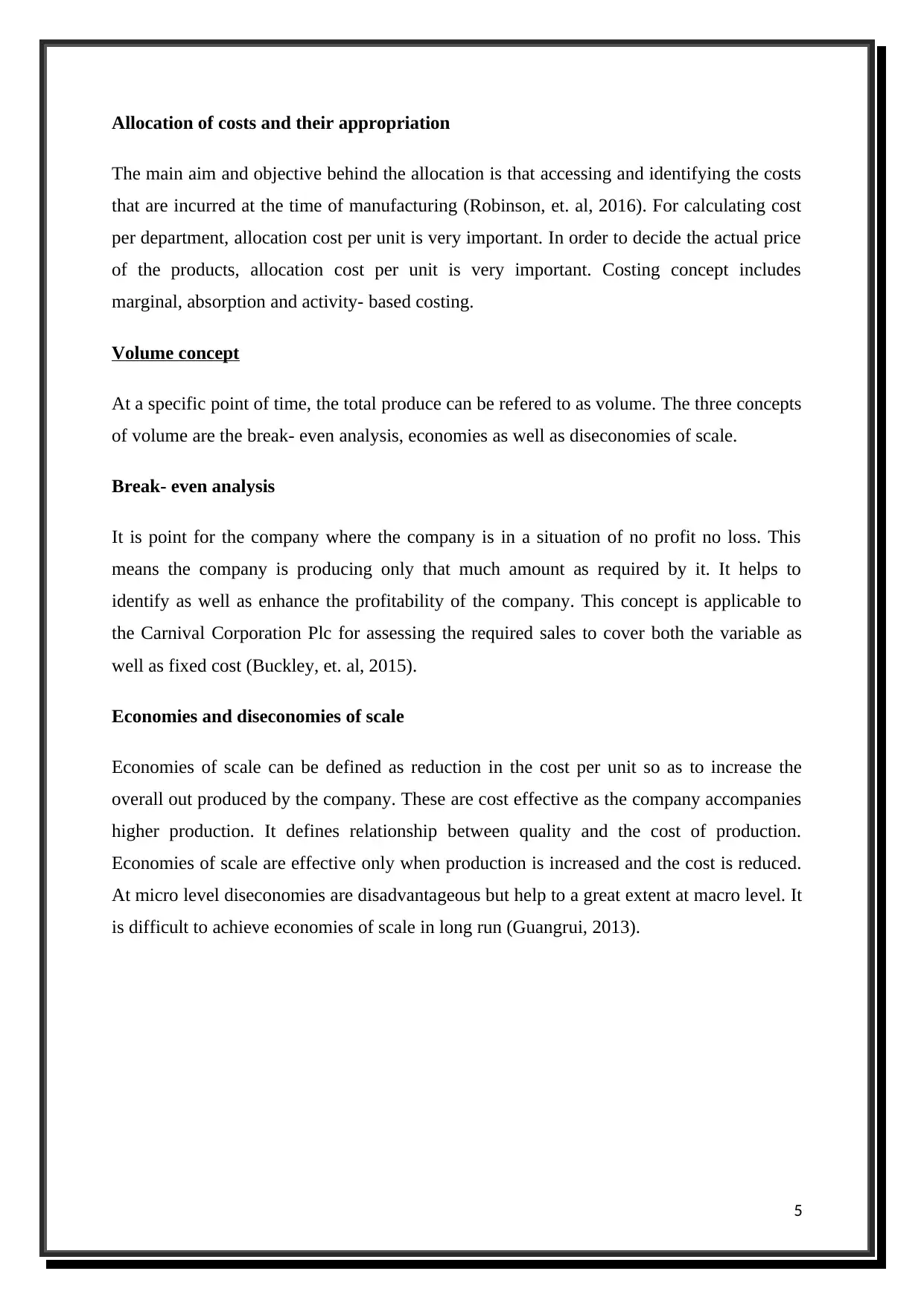
Allocation of costs and their appropriation
The main aim and objective behind the allocation is that accessing and identifying the costs
that are incurred at the time of manufacturing (Robinson, et. al, 2016). For calculating cost
per department, allocation cost per unit is very important. In order to decide the actual price
of the products, allocation cost per unit is very important. Costing concept includes
marginal, absorption and activity- based costing.
Volume concept
At a specific point of time, the total produce can be refered to as volume. The three concepts
of volume are the break- even analysis, economies as well as diseconomies of scale.
Break- even analysis
It is point for the company where the company is in a situation of no profit no loss. This
means the company is producing only that much amount as required by it. It helps to
identify as well as enhance the profitability of the company. This concept is applicable to
the Carnival Corporation Plc for assessing the required sales to cover both the variable as
well as fixed cost (Buckley, et. al, 2015).
Economies and diseconomies of scale
Economies of scale can be defined as reduction in the cost per unit so as to increase the
overall out produced by the company. These are cost effective as the company accompanies
higher production. It defines relationship between quality and the cost of production.
Economies of scale are effective only when production is increased and the cost is reduced.
At micro level diseconomies are disadvantageous but help to a great extent at macro level. It
is difficult to achieve economies of scale in long run (Guangrui, 2013).
5
The main aim and objective behind the allocation is that accessing and identifying the costs
that are incurred at the time of manufacturing (Robinson, et. al, 2016). For calculating cost
per department, allocation cost per unit is very important. In order to decide the actual price
of the products, allocation cost per unit is very important. Costing concept includes
marginal, absorption and activity- based costing.
Volume concept
At a specific point of time, the total produce can be refered to as volume. The three concepts
of volume are the break- even analysis, economies as well as diseconomies of scale.
Break- even analysis
It is point for the company where the company is in a situation of no profit no loss. This
means the company is producing only that much amount as required by it. It helps to
identify as well as enhance the profitability of the company. This concept is applicable to
the Carnival Corporation Plc for assessing the required sales to cover both the variable as
well as fixed cost (Buckley, et. al, 2015).
Economies and diseconomies of scale
Economies of scale can be defined as reduction in the cost per unit so as to increase the
overall out produced by the company. These are cost effective as the company accompanies
higher production. It defines relationship between quality and the cost of production.
Economies of scale are effective only when production is increased and the cost is reduced.
At micro level diseconomies are disadvantageous but help to a great extent at macro level. It
is difficult to achieve economies of scale in long run (Guangrui, 2013).
5
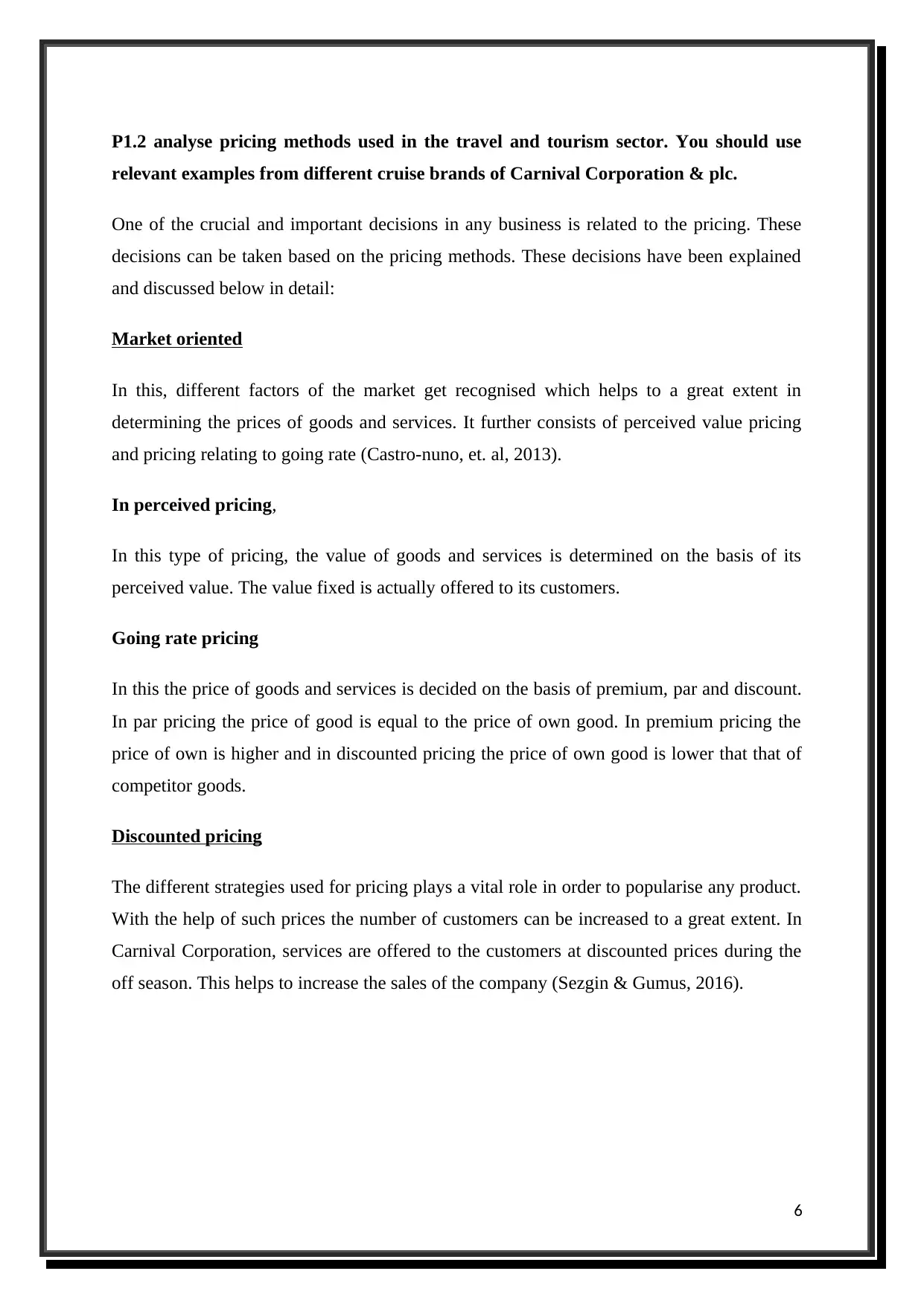
P1.2 analyse pricing methods used in the travel and tourism sector. You should use
relevant examples from different cruise brands of Carnival Corporation & plc.
One of the crucial and important decisions in any business is related to the pricing. These
decisions can be taken based on the pricing methods. These decisions have been explained
and discussed below in detail:
Market oriented
In this, different factors of the market get recognised which helps to a great extent in
determining the prices of goods and services. It further consists of perceived value pricing
and pricing relating to going rate (Castro-nuno, et. al, 2013).
In perceived pricing,
In this type of pricing, the value of goods and services is determined on the basis of its
perceived value. The value fixed is actually offered to its customers.
Going rate pricing
In this the price of goods and services is decided on the basis of premium, par and discount.
In par pricing the price of good is equal to the price of own good. In premium pricing the
price of own is higher and in discounted pricing the price of own good is lower that that of
competitor goods.
Discounted pricing
The different strategies used for pricing plays a vital role in order to popularise any product.
With the help of such prices the number of customers can be increased to a great extent. In
Carnival Corporation, services are offered to the customers at discounted prices during the
off season. This helps to increase the sales of the company (Sezgin & Gumus, 2016).
6
relevant examples from different cruise brands of Carnival Corporation & plc.
One of the crucial and important decisions in any business is related to the pricing. These
decisions can be taken based on the pricing methods. These decisions have been explained
and discussed below in detail:
Market oriented
In this, different factors of the market get recognised which helps to a great extent in
determining the prices of goods and services. It further consists of perceived value pricing
and pricing relating to going rate (Castro-nuno, et. al, 2013).
In perceived pricing,
In this type of pricing, the value of goods and services is determined on the basis of its
perceived value. The value fixed is actually offered to its customers.
Going rate pricing
In this the price of goods and services is decided on the basis of premium, par and discount.
In par pricing the price of good is equal to the price of own good. In premium pricing the
price of own is higher and in discounted pricing the price of own good is lower that that of
competitor goods.
Discounted pricing
The different strategies used for pricing plays a vital role in order to popularise any product.
With the help of such prices the number of customers can be increased to a great extent. In
Carnival Corporation, services are offered to the customers at discounted prices during the
off season. This helps to increase the sales of the company (Sezgin & Gumus, 2016).
6
⊘ This is a preview!⊘
Do you want full access?
Subscribe today to unlock all pages.

Trusted by 1+ million students worldwide
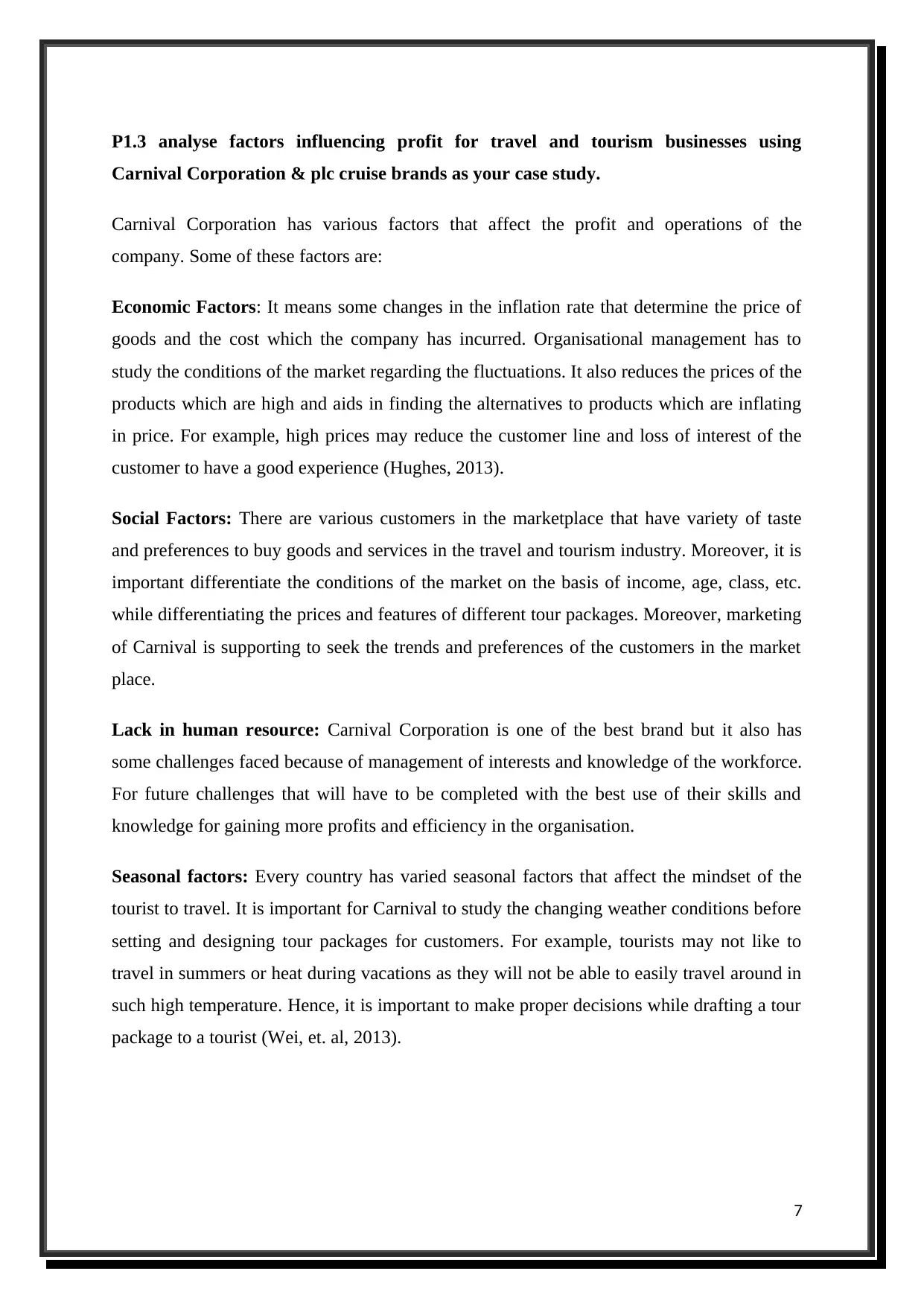
P1.3 analyse factors influencing profit for travel and tourism businesses using
Carnival Corporation & plc cruise brands as your case study.
Carnival Corporation has various factors that affect the profit and operations of the
company. Some of these factors are:
Economic Factors: It means some changes in the inflation rate that determine the price of
goods and the cost which the company has incurred. Organisational management has to
study the conditions of the market regarding the fluctuations. It also reduces the prices of the
products which are high and aids in finding the alternatives to products which are inflating
in price. For example, high prices may reduce the customer line and loss of interest of the
customer to have a good experience (Hughes, 2013).
Social Factors: There are various customers in the marketplace that have variety of taste
and preferences to buy goods and services in the travel and tourism industry. Moreover, it is
important differentiate the conditions of the market on the basis of income, age, class, etc.
while differentiating the prices and features of different tour packages. Moreover, marketing
of Carnival is supporting to seek the trends and preferences of the customers in the market
place.
Lack in human resource: Carnival Corporation is one of the best brand but it also has
some challenges faced because of management of interests and knowledge of the workforce.
For future challenges that will have to be completed with the best use of their skills and
knowledge for gaining more profits and efficiency in the organisation.
Seasonal factors: Every country has varied seasonal factors that affect the mindset of the
tourist to travel. It is important for Carnival to study the changing weather conditions before
setting and designing tour packages for customers. For example, tourists may not like to
travel in summers or heat during vacations as they will not be able to easily travel around in
such high temperature. Hence, it is important to make proper decisions while drafting a tour
package to a tourist (Wei, et. al, 2013).
7
Carnival Corporation & plc cruise brands as your case study.
Carnival Corporation has various factors that affect the profit and operations of the
company. Some of these factors are:
Economic Factors: It means some changes in the inflation rate that determine the price of
goods and the cost which the company has incurred. Organisational management has to
study the conditions of the market regarding the fluctuations. It also reduces the prices of the
products which are high and aids in finding the alternatives to products which are inflating
in price. For example, high prices may reduce the customer line and loss of interest of the
customer to have a good experience (Hughes, 2013).
Social Factors: There are various customers in the marketplace that have variety of taste
and preferences to buy goods and services in the travel and tourism industry. Moreover, it is
important differentiate the conditions of the market on the basis of income, age, class, etc.
while differentiating the prices and features of different tour packages. Moreover, marketing
of Carnival is supporting to seek the trends and preferences of the customers in the market
place.
Lack in human resource: Carnival Corporation is one of the best brand but it also has
some challenges faced because of management of interests and knowledge of the workforce.
For future challenges that will have to be completed with the best use of their skills and
knowledge for gaining more profits and efficiency in the organisation.
Seasonal factors: Every country has varied seasonal factors that affect the mindset of the
tourist to travel. It is important for Carnival to study the changing weather conditions before
setting and designing tour packages for customers. For example, tourists may not like to
travel in summers or heat during vacations as they will not be able to easily travel around in
such high temperature. Hence, it is important to make proper decisions while drafting a tour
package to a tourist (Wei, et. al, 2013).
7
Paraphrase This Document
Need a fresh take? Get an instant paraphrase of this document with our AI Paraphraser

Task 2
P2.1 Explain different types of management accounting information that could be used
in travel and tourism businesses using Dalata Hotel Group plc as your case study.
P2.2 assess the use of management accounting information as a decision-making tool
for Dalata Hotel Group plc
Explanation: Dalata Hotel Group PLC uses many management accounting methods to
study their acts in the outside world. They gather information from many sources and then
study that information so that to get accurate results. Management accounting is a procedure
through which the studying of the financials of the Dalata Hotel Group is done. The
outcomes of these results help the management of the company to make strategic decisions.
The study of the financial statements shows the generation of cash and the deviation
between the assets and the liabilities. The Dalata Hotel Group is studying the fields where
8
P2.1 Explain different types of management accounting information that could be used
in travel and tourism businesses using Dalata Hotel Group plc as your case study.
P2.2 assess the use of management accounting information as a decision-making tool
for Dalata Hotel Group plc
Explanation: Dalata Hotel Group PLC uses many management accounting methods to
study their acts in the outside world. They gather information from many sources and then
study that information so that to get accurate results. Management accounting is a procedure
through which the studying of the financials of the Dalata Hotel Group is done. The
outcomes of these results help the management of the company to make strategic decisions.
The study of the financial statements shows the generation of cash and the deviation
between the assets and the liabilities. The Dalata Hotel Group is studying the fields where
8

some changes can be done to generate more and more profits. Planning is very important in
all the companies as it helps in cost reduction and helps in setting the future perspective.
There is need to evaluate alternatives which can be used for a product. Hence, it is written
that every company should see and examine its financial statements properly as it will aid in
seeing the financial position as well as the performance of the Dalata Hotel Group PLC
(Khan, 2014).
9
all the companies as it helps in cost reduction and helps in setting the future perspective.
There is need to evaluate alternatives which can be used for a product. Hence, it is written
that every company should see and examine its financial statements properly as it will aid in
seeing the financial position as well as the performance of the Dalata Hotel Group PLC
(Khan, 2014).
9
⊘ This is a preview!⊘
Do you want full access?
Subscribe today to unlock all pages.

Trusted by 1+ million students worldwide
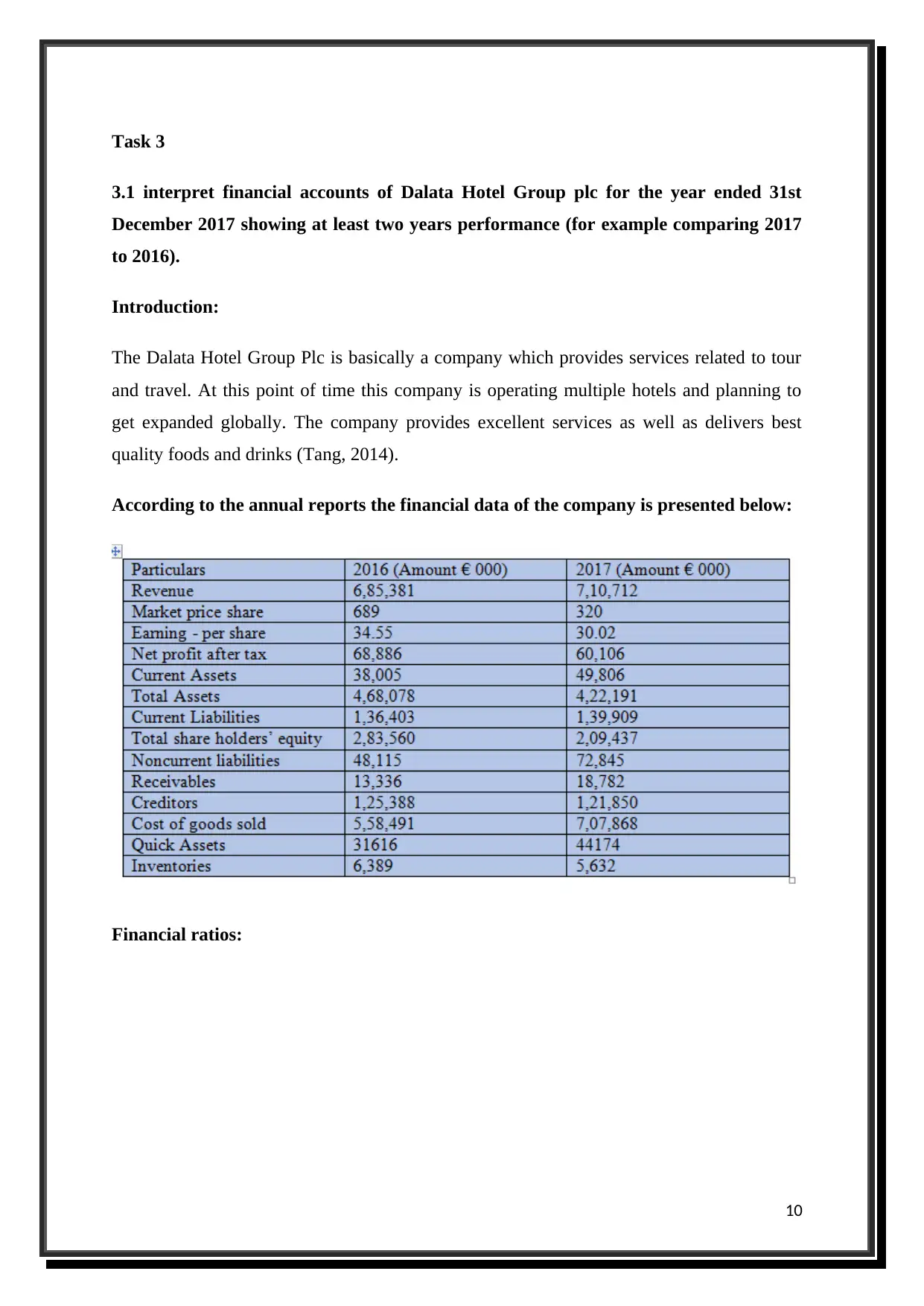
Task 3
3.1 interpret financial accounts of Dalata Hotel Group plc for the year ended 31st
December 2017 showing at least two years performance (for example comparing 2017
to 2016).
Introduction:
The Dalata Hotel Group Plc is basically a company which provides services related to tour
and travel. At this point of time this company is operating multiple hotels and planning to
get expanded globally. The company provides excellent services as well as delivers best
quality foods and drinks (Tang, 2014).
According to the annual reports the financial data of the company is presented below:
Financial ratios:
10
3.1 interpret financial accounts of Dalata Hotel Group plc for the year ended 31st
December 2017 showing at least two years performance (for example comparing 2017
to 2016).
Introduction:
The Dalata Hotel Group Plc is basically a company which provides services related to tour
and travel. At this point of time this company is operating multiple hotels and planning to
get expanded globally. The company provides excellent services as well as delivers best
quality foods and drinks (Tang, 2014).
According to the annual reports the financial data of the company is presented below:
Financial ratios:
10
Paraphrase This Document
Need a fresh take? Get an instant paraphrase of this document with our AI Paraphraser
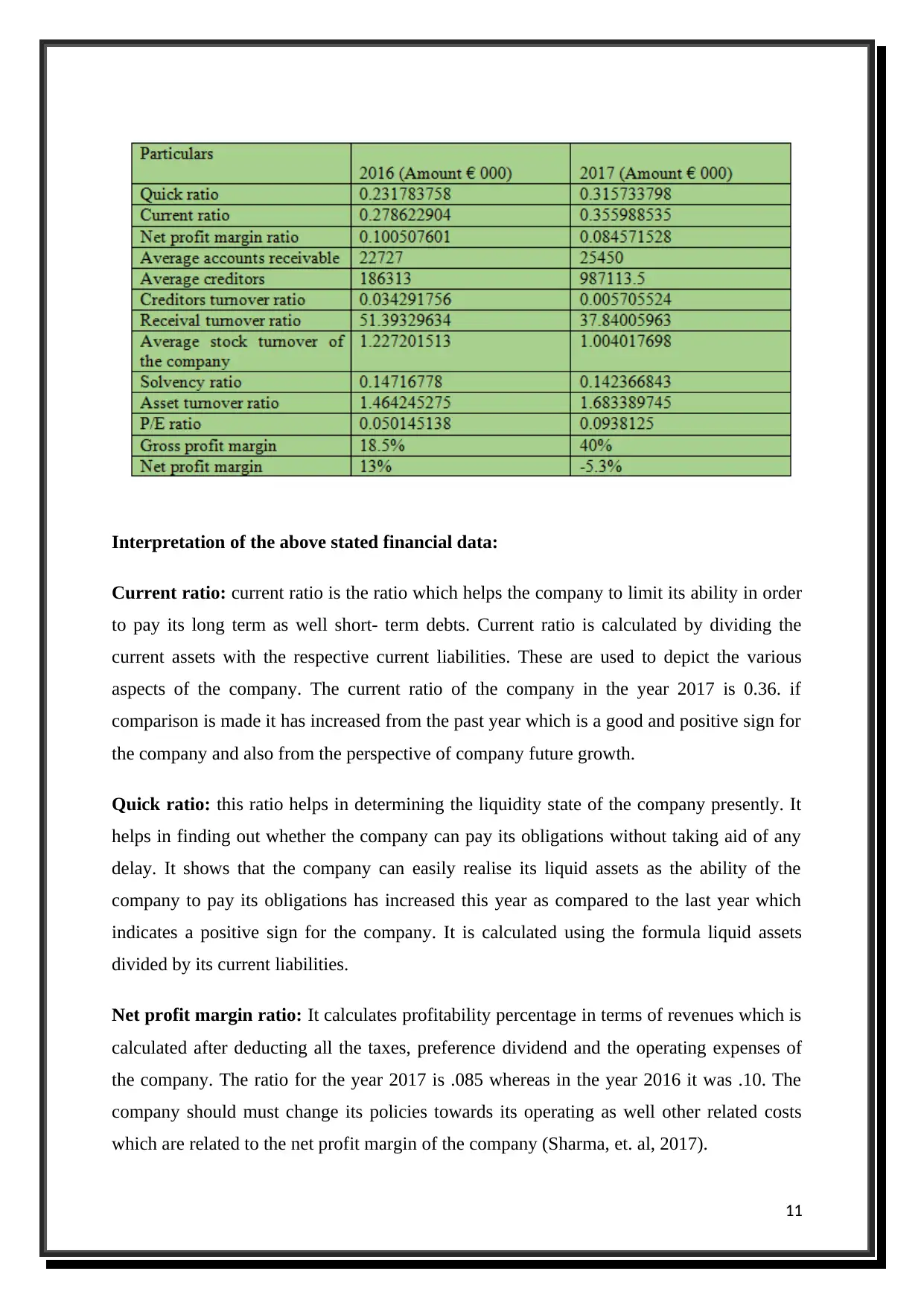
Interpretation of the above stated financial data:
Current ratio: current ratio is the ratio which helps the company to limit its ability in order
to pay its long term as well short- term debts. Current ratio is calculated by dividing the
current assets with the respective current liabilities. These are used to depict the various
aspects of the company. The current ratio of the company in the year 2017 is 0.36. if
comparison is made it has increased from the past year which is a good and positive sign for
the company and also from the perspective of company future growth.
Quick ratio: this ratio helps in determining the liquidity state of the company presently. It
helps in finding out whether the company can pay its obligations without taking aid of any
delay. It shows that the company can easily realise its liquid assets as the ability of the
company to pay its obligations has increased this year as compared to the last year which
indicates a positive sign for the company. It is calculated using the formula liquid assets
divided by its current liabilities.
Net profit margin ratio: It calculates profitability percentage in terms of revenues which is
calculated after deducting all the taxes, preference dividend and the operating expenses of
the company. The ratio for the year 2017 is .085 whereas in the year 2016 it was .10. The
company should must change its policies towards its operating as well other related costs
which are related to the net profit margin of the company (Sharma, et. al, 2017).
11
Current ratio: current ratio is the ratio which helps the company to limit its ability in order
to pay its long term as well short- term debts. Current ratio is calculated by dividing the
current assets with the respective current liabilities. These are used to depict the various
aspects of the company. The current ratio of the company in the year 2017 is 0.36. if
comparison is made it has increased from the past year which is a good and positive sign for
the company and also from the perspective of company future growth.
Quick ratio: this ratio helps in determining the liquidity state of the company presently. It
helps in finding out whether the company can pay its obligations without taking aid of any
delay. It shows that the company can easily realise its liquid assets as the ability of the
company to pay its obligations has increased this year as compared to the last year which
indicates a positive sign for the company. It is calculated using the formula liquid assets
divided by its current liabilities.
Net profit margin ratio: It calculates profitability percentage in terms of revenues which is
calculated after deducting all the taxes, preference dividend and the operating expenses of
the company. The ratio for the year 2017 is .085 whereas in the year 2016 it was .10. The
company should must change its policies towards its operating as well other related costs
which are related to the net profit margin of the company (Sharma, et. al, 2017).
11
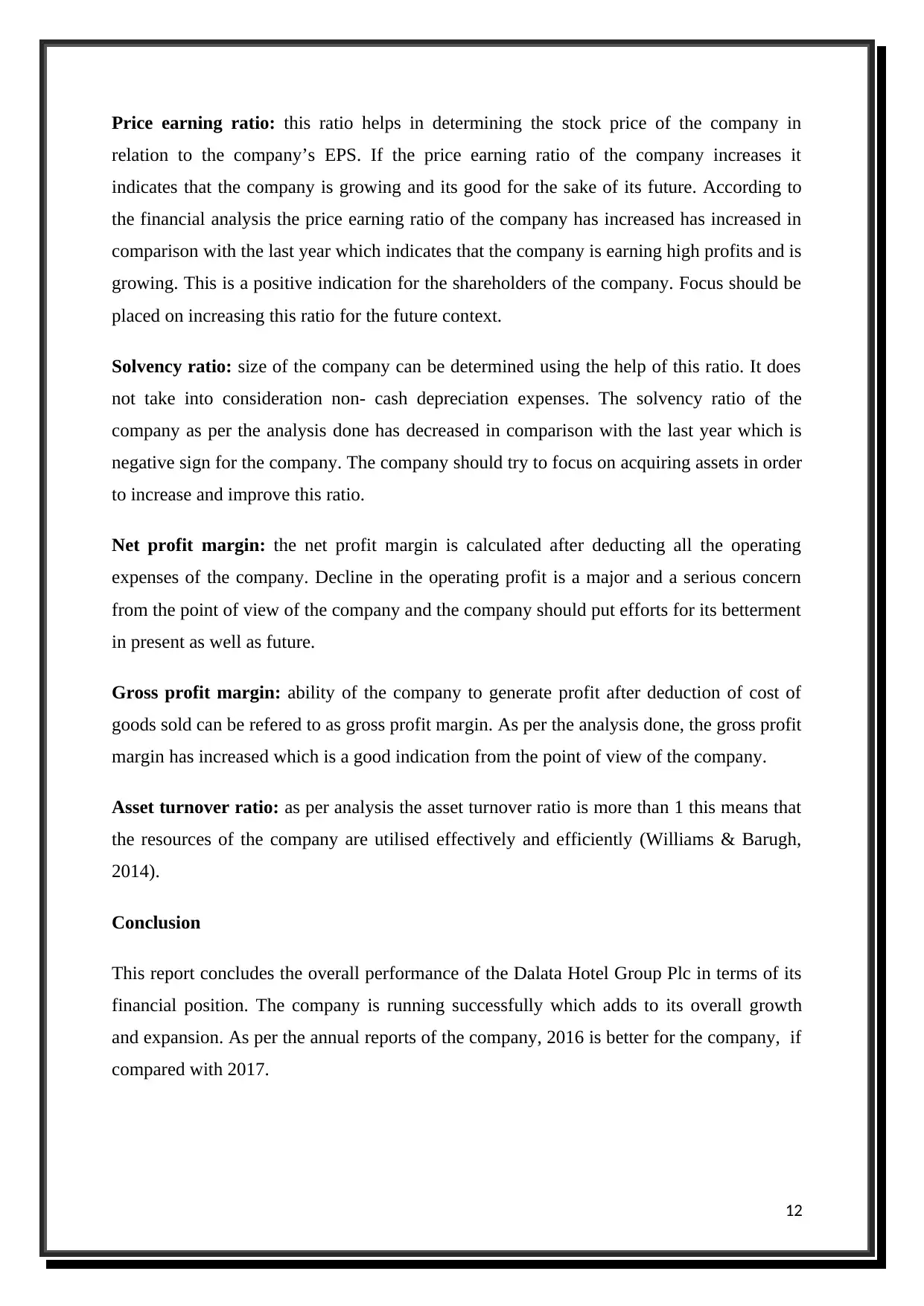
Price earning ratio: this ratio helps in determining the stock price of the company in
relation to the company’s EPS. If the price earning ratio of the company increases it
indicates that the company is growing and its good for the sake of its future. According to
the financial analysis the price earning ratio of the company has increased has increased in
comparison with the last year which indicates that the company is earning high profits and is
growing. This is a positive indication for the shareholders of the company. Focus should be
placed on increasing this ratio for the future context.
Solvency ratio: size of the company can be determined using the help of this ratio. It does
not take into consideration non- cash depreciation expenses. The solvency ratio of the
company as per the analysis done has decreased in comparison with the last year which is
negative sign for the company. The company should try to focus on acquiring assets in order
to increase and improve this ratio.
Net profit margin: the net profit margin is calculated after deducting all the operating
expenses of the company. Decline in the operating profit is a major and a serious concern
from the point of view of the company and the company should put efforts for its betterment
in present as well as future.
Gross profit margin: ability of the company to generate profit after deduction of cost of
goods sold can be refered to as gross profit margin. As per the analysis done, the gross profit
margin has increased which is a good indication from the point of view of the company.
Asset turnover ratio: as per analysis the asset turnover ratio is more than 1 this means that
the resources of the company are utilised effectively and efficiently (Williams & Barugh,
2014).
Conclusion
This report concludes the overall performance of the Dalata Hotel Group Plc in terms of its
financial position. The company is running successfully which adds to its overall growth
and expansion. As per the annual reports of the company, 2016 is better for the company, if
compared with 2017.
12
relation to the company’s EPS. If the price earning ratio of the company increases it
indicates that the company is growing and its good for the sake of its future. According to
the financial analysis the price earning ratio of the company has increased has increased in
comparison with the last year which indicates that the company is earning high profits and is
growing. This is a positive indication for the shareholders of the company. Focus should be
placed on increasing this ratio for the future context.
Solvency ratio: size of the company can be determined using the help of this ratio. It does
not take into consideration non- cash depreciation expenses. The solvency ratio of the
company as per the analysis done has decreased in comparison with the last year which is
negative sign for the company. The company should try to focus on acquiring assets in order
to increase and improve this ratio.
Net profit margin: the net profit margin is calculated after deducting all the operating
expenses of the company. Decline in the operating profit is a major and a serious concern
from the point of view of the company and the company should put efforts for its betterment
in present as well as future.
Gross profit margin: ability of the company to generate profit after deduction of cost of
goods sold can be refered to as gross profit margin. As per the analysis done, the gross profit
margin has increased which is a good indication from the point of view of the company.
Asset turnover ratio: as per analysis the asset turnover ratio is more than 1 this means that
the resources of the company are utilised effectively and efficiently (Williams & Barugh,
2014).
Conclusion
This report concludes the overall performance of the Dalata Hotel Group Plc in terms of its
financial position. The company is running successfully which adds to its overall growth
and expansion. As per the annual reports of the company, 2016 is better for the company, if
compared with 2017.
12
⊘ This is a preview!⊘
Do you want full access?
Subscribe today to unlock all pages.

Trusted by 1+ million students worldwide
1 out of 16
Related Documents
Your All-in-One AI-Powered Toolkit for Academic Success.
+13062052269
info@desklib.com
Available 24*7 on WhatsApp / Email
![[object Object]](/_next/static/media/star-bottom.7253800d.svg)
Unlock your academic potential
Copyright © 2020–2025 A2Z Services. All Rights Reserved. Developed and managed by ZUCOL.





